 W
WAdobe Authorware was an interpreted, flowchart-based, graphical programming language. Authorware is used for creating interactive programs that can integrate a range of multimedia content, particularly electronic educational technology applications. The flowchart model differentiates Authorware from other authoring tools, such as Adobe Flash and Adobe Director, which rely on a visual stage, time-line and script structure.
 W
WAgentCubes is an educational programming language for children to create 3D and 2D online games and simulations. The main application of AgentCubes is as computational thinking tool teaching children computational thinking through game and simulation design based on the Scalable Game Design curriculum.
 W
WAgentSheets was the first modern block-based programming language for kids. The idea of AgentSheets was to overcome syntactic challenges found in common text-based programming languages by using drag and drop mechanisms conceptualizing commands such as conditions and actions as editable blocks that could be composed into programs. AgentSheets is used to create media-rich projects such as games and interactive simulations. The main building blocks of AgentSheets are agents which are interactive objects programmed through rules. Using conditions agents can sense the user input including mouse, keyboard and in some versions even speech recognition and web page content. Using actions agents can move, produce sounds, open web pages, and compute formulae.
 W
WAlice is an object-based educational programming language with an integrated development environment (IDE). Alice uses a drag and drop environment to create computer animations using 3D models. The software was developed first at University of Virginia in 1994, then Carnegie Mellon, by a research group led by Randy Pausch.
 W
WArtspeak is a computer language conceived by Jacob T. Schwartz at New York University's Courant Institute of Mathematical Sciences. Until 2011, the only known compiler/interpreter was written for the CDC 6600, a mainframe computer. In order to program in Artspeak on the CDC 6600, one had to use punch cards and utilize batch processing.
 W
WBlueJ is an integrated development environment (IDE) for the Java programming language, developed mainly for educational purposes, but also suitable for small-scale software development. It runs with the help of JDK.
 W
WFlowgorithm is a graphical authoring tool which allows users to write and execute programs using flowcharts. The approach is designed to emphasize the algorithm rather than the syntax of a specific programming language. The flowchart can be converted to several major programming languages. Flowgorithm was created at Sacramento State University.
 W
WFMSLogo is a free implementation of a computing environment called Logo, which is an educational interpreter language. GUI and Extensions were developed by George Mills at MIT. Its core is the same as UCBLogo by Brian Harvey. It is free software, with source available, written with Borland C++ and WxWidgets.
 W
WGDevelop is a 2D cross-platform, free and open-source game engine, which mainly focuses on creating PC and Mobile games, as well as HTML5 games playable in the browser. Created by Florian Rival, a software engineer at Google, GDevelop is mainly aimed at non-programmers and game developers of all skillsets, employing event based visual programming similar to such engines as Construct and Stencyl.
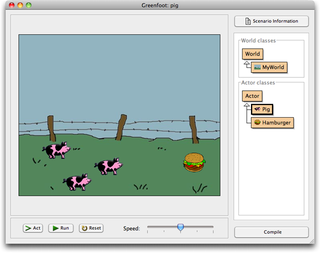 W
WGreenfoot is an integrated development environment using Java or Stride designed primarily for educational purposes at the high school and undergraduate level. It allows easy development of two-dimensional graphical applications, such as simulations and interactive games.
 W
WHackety Hack is an open source application that teaches individuals how to create software. It combines an IDE with an extensive Lessons system. The cross-platform desktop application also has integration with the website, where "Hackers" can share what they've learned, ask questions, and submit feedback.
 W
WJFLAP is interactive educational software written in Java for experimenting with topics in the computer science area of formal languages and automata theory, primarily intended for use at the undergraduate level or as an advanced topic for high school. JFLAP allows one to create and simulate structures, such as programming a finite state machine, and experiment with proofs, such as converting a nondeterministic finite automaton (NFA) to a deterministic finite automaton (DFA).
 W
WKarel is an educational programming language for beginners, created by Richard E. Pattis in his book Karel The Robot: A Gentle Introduction to the Art of Programming. Pattis used the language in his courses at Stanford University, California. The language is named after Karel Čapek, a Czech writer who introduced the word robot in his play R.U.R.
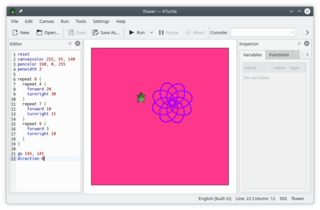 W
WKTurtle is an educational programming environment for turtle graphics. It is released under the open-source GNU General Public License and is part of the KDE Project since KDE3. KTurtle includes an IDE and a programming language which is loosely based on Logo and is intended for teaching programming.
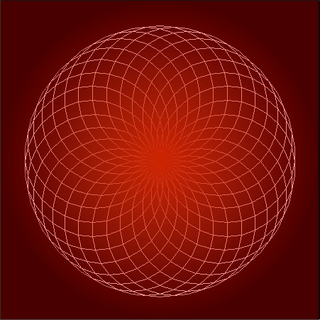 W
WLogo is an educational programming language, designed in 1967 by Wally Feurzeig, Seymour Papert, and Cynthia Solomon. Logo is not an acronym: the name was coined by Feurzeig while he was at Bolt, Beranek and Newman, and derives from the Greek logos, meaning word or thought.
 W
WLogo is an educational programming language, designed in 1967 by Wally Feurzeig, Seymour Papert, and Cynthia Solomon. Logo is not an acronym: the name was coined by Feurzeig while he was at Bolt, Beranek and Newman, and derives from the Greek logos, meaning word or thought.
 W
WMama is an object-oriented educational programming language designed to help young students start programming by providing all language elements in the student mother tongue. Mama programming language is available in several languages, with both left-to-right (LTR) and right-to-left (RTL) language direction support.
 W
WMicrosoft Small Basic is a programming language, interpreter and associated IDE. Microsoft's simplified variant of BASIC, it is designed to help students who have learnt visual programming languages such as Scratch learn text-based programming. The associated IDE provides a simplified programming environment with functionality such as syntax highlighting, intelligent code completion, and in-editor documentation access. The language has only 14 keywords.
 W
WPascal is an imperative and procedural programming language, designed by Niklaus Wirth as a small, efficient language intended to encourage good programming practices using structured programming and data structuring. It is named in honour of the French mathematician, philosopher and physicist Blaise Pascal.
 W
WProcessing is a free graphical library and integrated development environment (IDE) built for the electronic arts, new media art, and visual design communities with the purpose of teaching non-programmers the fundamentals of computer programming in a visual context.
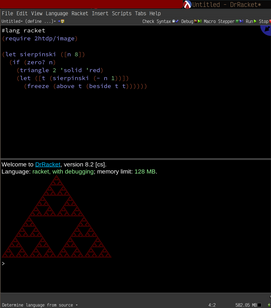 W
WRacket is a general-purpose, multi-paradigm programming language based on the Scheme dialect of Lisp. It is designed to be a platform for programming language design and implementation. In addition to the core Racket language, Racket is also used to refer to the family of programming languages and set of tools supporting development on and with Racket. Racket is also used for scripting, computer science education, and research.
 W
WRapira is an educational procedural programming language developed in the Soviet Union and implemented on Agat computer, PDP-11 clones and Intel-8080/Z80 clones (Korvet). It was an interpreted language with dynamic type system and high level constructions. The language originally had a Russian-based set of keywords, but English and Romanian were added later. Also, it was more elegant and easier to use than existing Pascal implementations of the time.
 W
WRAPTOR, the Rapid Algorithmic Prototyping Tool for Ordered Reasoning, is a graphical authoring tool created by Martin C. Carlisle, Terry Wilson, Jeff Humphries and Jason Moore. The software is hosted and maintained by former US Air Force Academy and current Carnegie Mellon University professor Martin Carlisle.
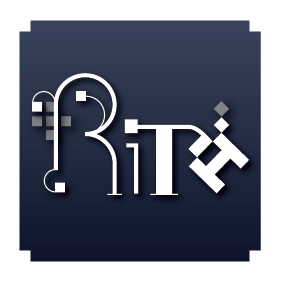 W
WRiTa is an open-source software toolkit for generative writing and natural language, originally developed using the Java language by Daniel C. Howe and collaborators, and later implemented in JavaScript as rita.js. Current versions of RiTa are implemented in both Java and JavaScript and integrate with p5.js, Processing, Node and Android.
 W
WRUR - Python Learning Environment (RUR-PLE) is an educational tool to help students learn the Python programming language. Made by André Roberge. RUR-PLE uses the idea behind Karel the Robot, making the learning of Python programming more interesting. A student writes a program that controls a 'robot' that moves through a city consisting of a rectangular grid of streets (left-right) and avenues (up-down).
 W
WScratch is a block-based visual programming language and website targeted primarily at children 8-16 as an educational tool for coding. Users of the site can create projects on the web using a block-like interface. The service is developed by the MIT Media Lab, has been translated into 70+ languages, and is used in most parts of the world. Scratch is taught and used in after-school centers, schools, and colleges, as well as other public knowledge institutions. As of March 2021, community statistics on the language's official website show more than 73 million projects shared by over 68 million users, and almost 38 million monthly website visits.
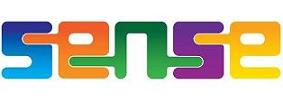 W
WSense is an educational programming environment created by The Open University (OU) in the United Kingdom. It uses a drag-and-drop programming environment designed to teach students the fundamentals of computer programming, using different shape and colour "blocks" selected from a palette of available commands, meaning that the student needs no prior experience of programming nor need to learn a syntax. It is based on the Scratch programming language developed by the MIT Media Lab, and uses .sb files like Scratch but the two pieces of software cannot use each other's files.
 W
WSnap! is a free, block-based educational graphical programming language and online community aimed at students to explore, create and re-mix interactive animations, games, stories, and more, while learning about mathematical and computational ideas. While inspired by Scratch, Snap! has many advanced features. The Snap! editor, and programs created in it, are web applications that run in the browser without requiring installation.
 W
WThe Squeak programming language is a dialect of Smalltalk. It is object-oriented, class-based, and reflective.
 W
WStencyl is a video game development tool that allows users to create 2D video games for computers, mobile devices, and the web. The software is available for free, with select publishing options available for purchase. The software was originally called "StencylWorks" while in development and for the initial release but was later shortened to just "Stencyl".
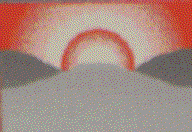 W
WTuring is a Pascal-like programming language developed in 1982 by Ric Holt and James Cordy, then of University of Toronto, in Toronto, Ontario, Canada. Turing is a descendant of Euclid, Pascal and SP/k that features a clean syntax and precise machine-independent semantics.
 W
WTynker is an educational programming platform aimed at teaching children how to make games and programs, where a user visually drag blocks of code and snap them together. The visual design and principles are based on the free Scratch. Tynker is based on HTML5 and JavaScript, and can be used in the browser without plugins, as well as on tablets and smartphones. Another difference is that Scratch is a free open source project, while Tynker is a commercial product, aimed at selling courses. Tynker offers self-paced online courses for children to learn coding at home, as well as an engaging programming curriculum for schools and camps. It makes it easier for kids to learn coding as it teaches kids coding through creating games like Minecraft, Hour of Code etc.
 W
WUCBLogo, also termed Berkeley Logo, is a programming language, a dialect of Logo, which derived from Lisp. It is the dialect of Logo closest to being a de facto standard. It has the best facilities for handling lists, files, input/output (I/O), and recursion. It can be used to teach most computer science concepts, as University of California, Berkeley lecturer Brian Harvey did in his Computer Science Logo Style trilogy. It is free and open-source software released under a GNU General Public License (GPL).
 W
WVisual Logic is a graphical authoring tool which allows students to write and execute programs using flowcharts. It is typically used in an academic setting to teach introductory programming concepts.
 W
WThe Wolfram Language is a general multi-paradigm programming language developed by Wolfram Research. It emphasizes symbolic computation, functional programming, and rule-based programming and can employ arbitrary structures and data. It is the programming language of the mathematical symbolic computation program Mathematica.